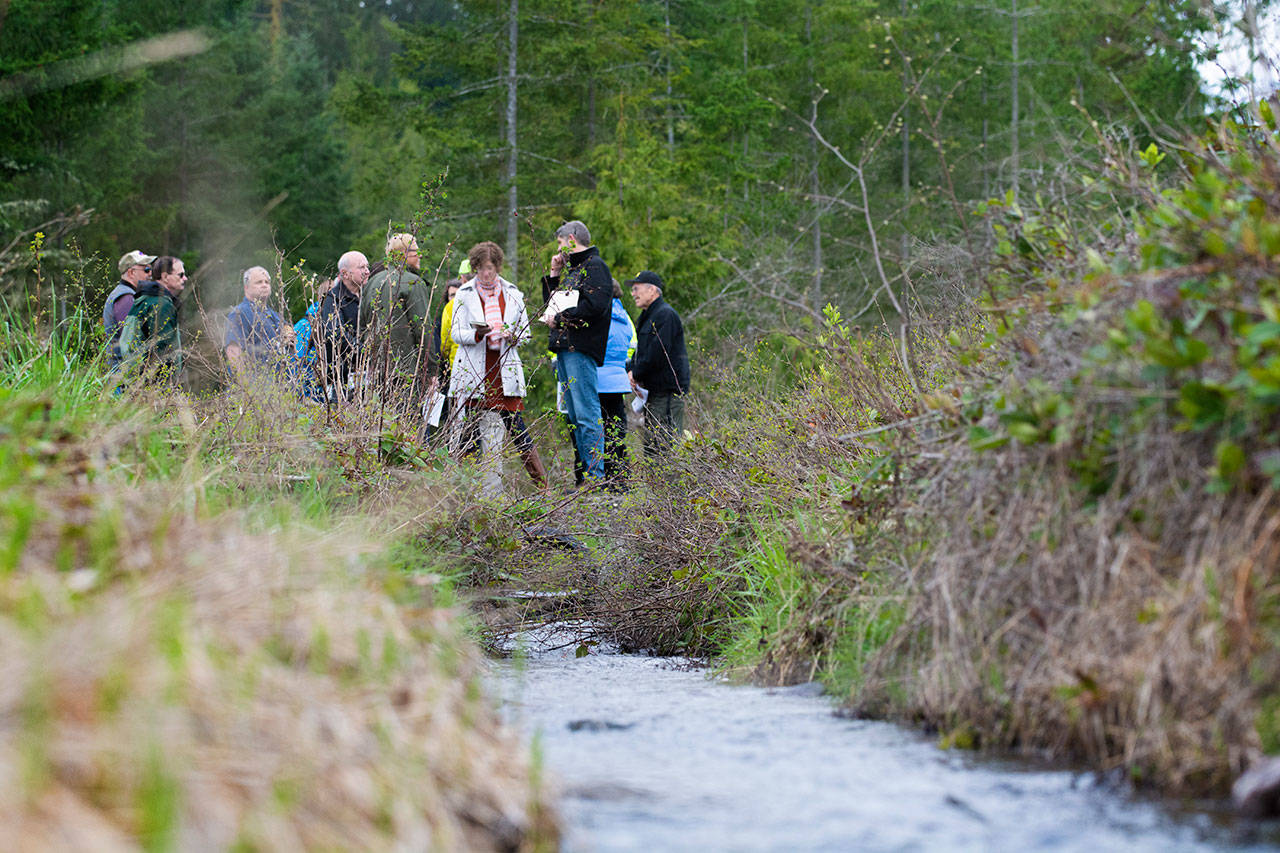On Earth Day, officials from the City of Sequim and Clallam County took a close look at the site of the proposed Dungeness Off-Channel Reservoir, a project that aims to conserve water in the Dungeness River Basin, protect salmon and recharge the aquifer.
“The purpose of bringing you all here today is to highlight this project, a significant investment in terms of local resources and the county’s most significant investment to date in a climate change adaptation project,” Clallam County Commissioner Mark Ozias said on April 22.
“Now that it’s getting at least closer to being a reality I wanted to give everyone a chance to get on site and start thinking about the future.”
In February the long-proposed project hit a major milestone: its first source of significant funding.
The Department of Ecology announced then that the county would receive a $4.1 million grant, money that will be used by the county to purchase land from the Department of Natural Resources and help fund design and engineering.
The project was first envisioned about 10 years ago by the Dungeness Reservoir Working Group coalition, which includes Clallam County, the City of Sequim, Jamestown S’Klallam Tribe, Dungeness Water Users Association, Clallam Conservation District, Ecology and the Washington Water Trust.
The 1,600 acre-foot reservoir would capture late winter high river flows from the Dungeness River and store it in the reservoir. Water from the reservoir would be used for irrigation, saving 25 cfs of flow in the Dungeness River to help support migrating salmonids.
“The Dungeness River has four different species of endangered salmon and those endangered species have driven a lot of the management work we have done collectively for these water resources,” Ozias said.
“When the reservoir is built … that reservoir will have enough water to provide for almost the entirety of the irrigation needs of the east side of the Dungeness River.”
He said the reservoir, which is expected to fill and drain twice each year, will be a working reservoir and not likely open to the public.
However, the land around the reservoir will be open for recreational use.
Ozias said there will be public outreach over the next year or year and a half to look at the potential recreational opportunities for the space.
Clallam County hydrogeologist Carol Creasey, the project manager, said she is thankful for the $4 million grant.
That’s because the overall project is expected to cost $25 million to $30 million, she said.
“Right now we’re in the midst of negotiating with Ecology and getting all the forms and contracting done,” Creasey said. “Ecology is having problems with their contracting software … and we’ve been on hold for a month and a half or two months, but they believe we should be able to get all the contracting done by the end of June of this year.”
The first task will be the land acquisition from DNR, which she estimated to cost $2.5 million.
She said an appraisal of the land will cost $30,000 and take about 6 months, while the acquisition from DNR will take up to 27 months.
The second task is hiring a consulting firm for design. She estimated the design will cost $1.3 million.
When the project is 30 percent designed the county can begin the permitting process and at 90 percent designed it can put out a request for proposals, she said.
Permitting will cost about $180,000, Creasey said and project management will cost about $120,000.
Creasey said the Washington Water Trust and partners have applied for a $3 million grant from National Oceanic and Atmospheric Administration, which would be matched by the Ecology grant.
Ann Soule, resource manager for the City of Sequim, said the city is working closely with the state Emergency Management Division on the project.
Not only will the project recharge the aquifer, but it will capture stormwater and help prevent flooding, she said.
She said the Emergency Management Division has supported the project and after more than two years of discussion the city is preparing to use the “climate resiliency” aspect of the project to apply for a Federal Emergency Management Agency grant.
“They’re helping us out and we’re finally, after 2.5 years, closing in on finalizing that grant application,” Soule said. “It has been a long process.”
Ozias said one of the strengths of the project is the multitude of benefits it will have for the area, which he said has presented a challenge for securing funding.
He said most funding streams are allocated for specific purposes while the reservoir has many benefits.
“We’ve really had to work hard to educate all of our funding partners about the entire scope and I think with this recent award from the Department of Ecology I hope that is one sign that we’ve turned the corner,” Ozias said.



